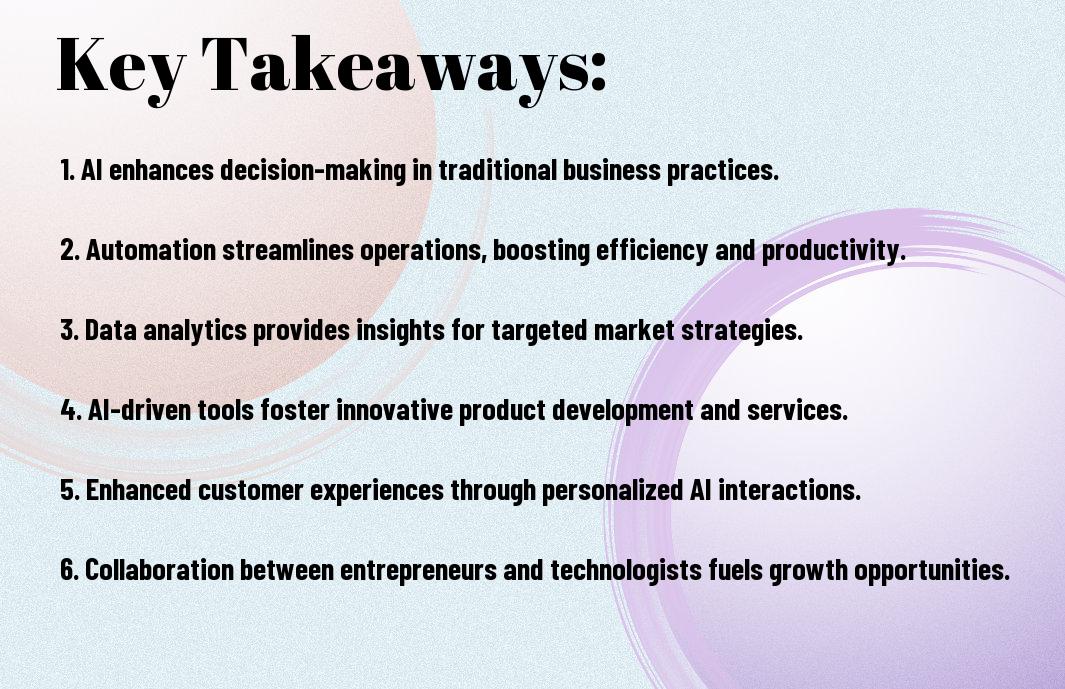As you navigate the ever-evolving landscape of entrepreneurship, you’re likely aware of the growing intersection of traditional business practices and modern technology. You may be wondering how to effectively merge these two worlds to drive innovation and success. Your ability to adapt and leverage artificial intelligence (AI) will be key to staying ahead of the curve, and this post will explore the ways in which AI is revolutionizing traditional entrepreneurship, enabling you to make informed decisions about your own business strategy.
Key Takeaways:
- Combining traditional entrepreneurship principles with modern AI technology can lead to innovative business models and increased efficiency, allowing entrepreneurs to stay competitive in a rapidly changing market.
- AI-driven tools can automate routine tasks, freeing up entrepreneurs to focus on high-level strategy and creative problem-solving, enabling them to make more informed decisions and drive business growth.
- The integration of AI in traditional entrepreneurship can also enhance customer experience, providing personalized services and improving customer engagement through data-driven insights and predictive analytics.
- Entrepreneurs who effectively merge traditional entrepreneurship with AI technology can gain a significant advantage over their competitors, driving innovation and disrupting industries with new and innovative products or services.
- The future of entrepreneurship will likely involve a seamless blend of human intuition and AI-driven insights, requiring entrepreneurs to develop a deep understanding of both traditional business principles and modern AI technologies to succeed.

The Evolution of Entrepreneurship
A look at the history of entrepreneurship shows that it has undergone significant transformations over the years, shaping the business landscape into what you see today, with various factors contributing to its growth and development, ultimately leading to the incorporation of modern technologies.
Traditional Business Models
By examining the past, you can see that traditional business models were often limited by their geographical location and market reach, restricting your ability to expand and connect with a broader audience, which in turn hindered your potential for growth and success.
The Digital Revolution
Digitally, the world has become more interconnected, allowing you to access a global market and leverage technology to streamline your business operations, making it easier for you to manage and scale your enterprise, and this shift has significantly impacted the way you approach entrepreneurship.
Due to the advancements in technology and the rise of the digital age, you now have the opportunity to harness the power of artificial intelligence, data analytics, and other digital tools to drive innovation and stay competitive in the market, enabling you to make informed decisions and adapt to changing consumer needs and preferences, which is imperative for your business to thrive in today’s fast-paced environment.
AI as the Bridge
While navigating the intersection of traditional entrepreneurship and modern tech, you’ll find that AI plays a significant role in merging these two worlds, enabling you to leverage the best of both.
Cognitive Tools for Ancient Problems
Toward solving long-standing business challenges, you can utilize AI-powered cognitive tools that offer innovative solutions, allowing you to tackle complex issues with ease and efficiency, thereby enhancing your entrepreneurial endeavors.
Algorithmic Decision-Making
To make informed decisions, you can rely on algorithmic processes that analyze vast amounts of data, providing you with valuable insights that inform your business strategy and drive growth.
This ability to make data-driven decisions is particularly significant, as it enables you to optimize your operations, mitigate risks, and capitalize on new opportunities, ultimately giving you a competitive edge in the market and allowing you to stay ahead of the curve in your industry, with your business reaping the benefits of AI-driven decision-making.

The Human Element Preserved
Despite the rise of AI, you can still maintain the human touch in your entrepreneurship endeavors. As you explore the possibilities of AI, consider reading about Bridging the execution gap – why AI is the new frontier for corporate strategy to understand how AI merges with traditional entrepreneurship.
Intuition Meets Data
Beneath the surface of AI-driven decision-making, you’ll find that your intuition still plays a significant role. As you navigate the intersection of human insight and machine learning, you’ll discover new ways to inform your business strategy.
Values in the Machine Age
Essentially, you’ll need to consider the values that drive your business in the age of AI. Your approach to ethics, transparency, and accountability will be more important than ever as you integrate AI into your operations.
And as you probe deeper into the world of AI, you’ll find that your values are not only preserved but also amplified. You’ll have the opportunity to create a business that is more responsive, more responsible, and more aligned with your vision, allowing you to build a stronger connection with your customers and community.
Implementation Strategies
All successful entrepreneurs know that integrating AI into their business requires a well-thought-out plan. You need to consider your goals, resources, and current infrastructure to ensure a seamless transition. Your implementation strategy will serve as a roadmap, guiding you through the process and helping you avoid potential pitfalls.
Gradual Integration Methods
Implementing AI solutions gradually allows you to test and refine your approach as you go. You can start by automating simple tasks and then move on to more complex processes, ensuring that your systems and workforce are adapted to the new technology. Your business will benefit from a phased introduction of AI, minimizing disruptions and maximizing efficiency.
Workforce Adaptation
Before introducing AI to your business, you should assess your workforce’s readiness for the change. You need to consider the skills and training required for your employees to work effectively with AI systems. Your goal is to create a workforce that is not only comfortable with the new technology but also able to leverage its capabilities to drive innovation and growth.
Methods for adapting your workforce to AI-driven systems include providing comprehensive training programs, encouraging a culture of innovation, and fostering a mindset of continuous learning. You can also consider hiring professionals with expertise in AI and machine learning to help guide your team through the transition. By investing in your workforce, you will be able to unlock the full potential of AI and drive long-term success for your business.
Economic Implications
Once again, you will notice that the integration of AI in traditional entrepreneurship has significant effects on the economy, transforming the way you conduct business and make financial decisions.
Productivity Paradoxes
Profitably, you can increase efficiency and output with AI, but this may also lead to job displacement and changes in your workforce dynamics.
New Market Formations
Any analysis of AI’s impact on your business will show that new market opportunities emerge, allowing you to expand your customer base and develop innovative products.
Understanding the dynamics of these new markets is key to your success, as you will need to adapt your strategies to meet the evolving needs and preferences of your customers, and stay ahead of the competition in an increasingly tech-driven landscape.
Ethical Considerations
Not all AI applications are created equal, and as you begin on merging traditional entrepreneurship with modern tech, you must consider the ethical implications of your actions.
Bias in Automated Systems
The transparency of AI decision-making processes is crucial to identify and mitigate biases, and as you develop your AI-powered business, you should be aware of the potential for biased automated systems.
Governance Frameworks
For your AI-driven venture to succeed, you need to establish governance frameworks that ensure accountability and fairness, and you should prioritize the development of these frameworks from the outset.
Frameworks like these will help you navigate the complex ethical landscape of AI and ensure that your business is aligned with your values and the values of your customers, allowing you to build trust and maintain a competitive edge in the market, and as you move forward, you will be able to adapt these frameworks to meet the evolving needs of your business and the regulatory environment.
Conclusion
Considering all points, you now understand how AI merges traditional entrepreneurship with modern tech, transforming your business. You can leverage AI to streamline operations, enhance decision-making, and drive innovation. By embracing this synergy, you will stay ahead of the curve, unlocking new opportunities and maximizing your potential in the ever-evolving entrepreneurial landscape, making your venture more efficient and competitive.
FAQ
Q: What is the main goal of bridging the gap between traditional entrepreneurship and modern technology?
A: The primary objective of merging traditional entrepreneurship with modern tech is to leverage the strengths of both worlds, creating a harmonious blend of innovative ideas, cutting-edge technology, and time-tested business principles. By doing so, entrepreneurs can tap into new markets, streamline operations, and stay competitive in an ever-evolving business landscape. This integration enables businesses to adapt to changing consumer behaviors, improve customer experiences, and drive sustainable growth.
Q: How can artificial intelligence (AI) enhance traditional entrepreneurial ventures?
A: AI can significantly enhance traditional entrepreneurial ventures by automating routine tasks, providing data-driven insights, and enabling predictive decision-making. AI-powered tools can help entrepreneurs identify new business opportunities, optimize supply chains, and personalize customer interactions. Moreover, AI-driven analytics can facilitate market research, competitor analysis, and financial forecasting, allowing entrepreneurs to make informed decisions and mitigate risks. By embracing AI, traditional businesses can become more agile, efficient, and responsive to changing market conditions.
Q: What skills do entrepreneurs need to acquire to successfully merge traditional entrepreneurship with modern technology?
A: To successfully bridge the gap between traditional entrepreneurship and modern tech, entrepreneurs need to acquire a combination of skills, including digital literacy, data analysis, and strategic thinking. They should be familiar with emerging technologies like AI, blockchain, and the Internet of Things (IoT), and understand how to leverage these technologies to drive business growth. Additionally, entrepreneurs need to develop soft skills like adaptability, creativity, and collaboration to effectively work with cross-functional teams, including data scientists, software developers, and designers. By acquiring these skills, entrepreneurs can navigate the complexities of modern tech and create innovative, tech-enabled businesses that thrive in today’s fast-paced economy.



